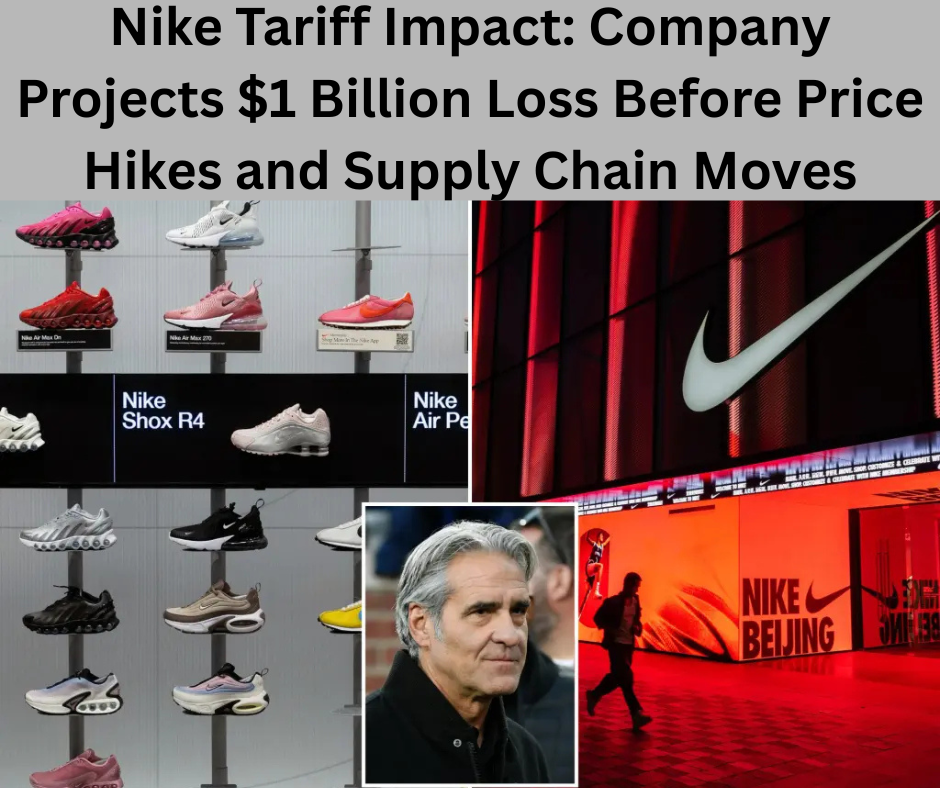Nike Tariff Impact: How Proposed Duties Could Hit $1 Billion in 2026
Nike has reported solid fiscal Q4 earnings, yet executives warned that the Nike tariff impact remains a major hurdle. The company forecasts up to a $1 billion additional cost this fiscal year—before accounting for upcoming price increases and supply chain shifts designed to offset the drag.
Nike Tariff Impact: Forecasted $1 Billion Strain
On its Q4 earnings call, Nike’s CFO Matt Friend described the tariffs as “new and meaningful”—forecasting a $1 billion gross incremental cost in fiscal 2026 attributable to duties on Chinese imports . Nike plans to spread this burden across price hikes, supplier restructuring, and sourcing changes.
Nike Tariff Impact: Supply Chain Realignment
Currently, roughly 16% of Nike’s production takes place in China. With the Nike tariff impact in mind, the company intends to reduce this to the “high single-digit” range by the end of the fiscal year . Nike still values its Chinese manufacturing base, citing its capacity and quality—but shifting sourcing towards countries like Vietnam, Indonesia, and Cambodia is already underway.
Nike Tariff Impact: How Nike Intends to Mitigate Costs
Nike’s mitigation strategy in response to tariff impact includes:
- Pricing adjustments: “Surgical price increase” planned for the U.S. market starting autumn .
- Sourcing diversification: Switch production away from China to reduce tariff exposure.
- Supply chain optimization: Leverage strong factory relationships to tweak production flow.
- Corporate efficiency: Planned overhead cuts targeted at minimizing margin pressure.
Despite this, Nike warns fiscal 2026 gross margins may drop by roughly 0.75 percentage points, with most impact appearing in the first half of the year .
Nike Tariff Impact: Q4 Performance Recap
Nike ended its fiscal Q4 with better-than-anticipated results despite tariff headwinds:
| Metric | Q4 2026 | Analyst Expectation (LSEG) |
|---|---|---|
| EPS | $0.14 | $0.13 |
| Revenue | $11.10B | $10.72B |
Net income plummeted to $211 million—a stark fall from $1.5 billion a year ago—primarily due to inventory markdowns, wholesale channel expansion, and tariff-related cost pressures . Q4 sales dropped approximately 12% year-over-year, with Nike’s digital revenue down 26%, wholesale down 9%, while its own stores showed a 2% increase .
Nike Tariff Impact: Regional & Retail Insights
- North America: Sales dipped 11% to $4.7B, still surpassing expectations .
- China: Revenue of $1.48B—slightly under expectations, with recovery expected to be slower due to local market complexities .
- Foot traffic: Declined 10.2% in April but improved to a 3.2% drop in May, suggesting early signs of consumer confidence returning .
Nike Tariff Impact: CEO & Analyst Commentary
Nike’s CEO Elliott Hill called Q4 the “low point” of its turnaround—signaling optimism for future progress . Hill emphasized refocusing efforts on core sports innovation and retail strategies, reversing excess inventory and wholesale drift.
Analysts remain cautious. Research firm Quilter Cheviot described Q4 as Nike’s “worst in at least two decades,” and noted the tariff impact as a fresh stressor .
Nike Tariff Impact: Addressing Strategic Adjustments
Nike is actively correcting course on several fronts:
- Sports-first focus: Reinforcing its athletic brand value through dedicated Nike, Jordan, and Converse teams .
- Wholesale partnerships: Reengaging with Amazon, Aritzia, and Urban Outfitters to expand reach .
- Female consumer growth: Delayed launch with SKIMS now slated for later this year—an important step given women represent 40% of Nike’s business .
Nike Tariff Impact: Long-Term Outlook
Though the Nike tariff impact represents a heavy near-term burden, company leaders remain confident in long-term stabilization. Their phased mitigation—through strategic sourcing, pricing, and improved operations—is expected to cushion future earnings.
As Hill noted, Q4 already represents the “worst” point, and Nike is now “turning the page” in its recovery journey .
Nike Tariff Impact: Key Takeaways
- Immediate cost shock: $1B tariff burden in fiscal 2026.
- Strategic response: Reducing China share; pivoting to Asia; passing inflation to consumers.
- Retail resilience: Strong Nike store performance; wholesale and digital still recovering.
- Turnaround assurance: Leadership remains optimistic about a recovery, with Q4 seen as the bottom.
Final Thoughts
Nike’s ability to weather the tariff impact showcases its operational strength. Its multi-pronged mitigation—price adjustments, supply chain diversification, and retail innovation—is carefully designed to offset these duties while ensuring future growth. If executed effectively, Nike can emerge from this turbulence not only stable but strategically stronger.
Read more: FTC Fortnite Refund

[…] of Hazzard Actor Dies at 79: TV Legend Remembered by Fans Worldwide Nike Tariff Impact: Company Projects $1 Billion Loss Before Price Hikes and Supply Chain Moves Jaish Terrorist Killed in J&K Operation Ahead of Amarnath Yatra; 3 Militants Trapped in […]
[…] Beating Pachuca Dukes of Hazzard Actor Dies at 79: TV Legend Remembered by Fans Worldwide Nike Tariff Impact: Company Projects $1 Billion Loss Before Price Hikes and Supply Chain Moves Jaish Terrorist Killed in J&K Operation Ahead of Amarnath Yatra; 3 Militants Trapped in […]